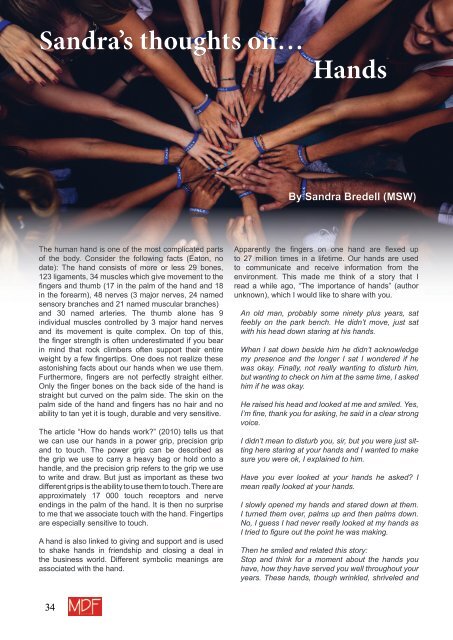MDF Magazine Newsletter Issue 59 August 2019
You also want an ePaper? Increase the reach of your titles
YUMPU automatically turns print PDFs into web optimized ePapers that Google loves.
Sandra’s thoughts on…<br />
Hands<br />
By Sandra Bredell (MSW)<br />
The human hand is one of the most complicated parts<br />
of the body. Consider the following facts (Eaton, no<br />
date): The hand consists of more or less 29 bones,<br />
123 ligaments, 34 muscles which give movement to the<br />
fingers and thumb (17 in the palm of the hand and 18<br />
in the forearm), 48 nerves (3 major nerves, 24 named<br />
sensory branches and 21 named muscular branches)<br />
and 30 named arteries. The thumb alone has 9<br />
individual muscles controlled by 3 major hand nerves<br />
and its movement is quite complex. On top of this,<br />
the finger strength is often underestimated if you bear<br />
in mind that rock climbers often support their entire<br />
weight by a few fingertips. One does not realize these<br />
astonishing facts about our hands when we use them.<br />
Furthermore, fingers are not perfectly straight either.<br />
Only the finger bones on the back side of the hand is<br />
straight but curved on the palm side. The skin on the<br />
palm side of the hand and fingers has no hair and no<br />
ability to tan yet it is tough, durable and very sensitive.<br />
The article “How do hands work?” (2010) tells us that<br />
we can use our hands in a power grip, precision grip<br />
and to touch. The power grip can be described as<br />
the grip we use to carry a heavy bag or hold onto a<br />
handle, and the precision grip refers to the grip we use<br />
to write and draw. But just as important as these two<br />
different grips is the ability to use them to touch. There are<br />
approximately 17 000 touch receptors and nerve<br />
endings in the palm of the hand. It is then no surprise<br />
to me that we associate touch with the hand. Fingertips<br />
are especially sensitive to touch.<br />
A hand is also linked to giving and support and is used<br />
to shake hands in friendship and closing a deal in<br />
the business world. Different symbolic meanings are<br />
associated with the hand.<br />
Apparently the fingers on one hand are flexed up<br />
to 27 million times in a lifetime. Our hands are used<br />
to communicate and receive information from the<br />
environment. This made me think of a story that I<br />
read a while ago, “The importance of hands” (author<br />
unknown), which I would like to share with you.<br />
An old man, probably some ninety plus years, sat<br />
feebly on the park bench. He didn’t move, just sat<br />
with his head down staring at his hands.<br />
When I sat down beside him he didn’t acknowledge<br />
my presence and the longer I sat I wondered if he<br />
was okay. Finally, not really wanting to disturb him,<br />
but wanting to check on him at the same time, I asked<br />
him if he was okay.<br />
He raised his head and looked at me and smiled. Yes,<br />
I’m fine, thank you for asking, he said in a clear strong<br />
voice.<br />
I didn’t mean to disturb you, sir, but you were just sitting<br />
here staring at your hands and I wanted to make<br />
sure you were ok, I explained to him.<br />
Have you ever looked at your hands he asked? I<br />
mean really looked at your hands.<br />
I slowly opened my hands and stared down at them.<br />
I turned them over, palms up and then palms down.<br />
No, I guess I had never really looked at my hands as<br />
I tried to figure out the point he was making.<br />
Then he smiled and related this story:<br />
Stop and think for a moment about the hands you<br />
have, how they have served you well throughout your<br />
years. These hands, though wrinkled, shriveled and<br />
34


















